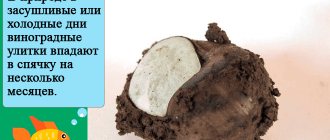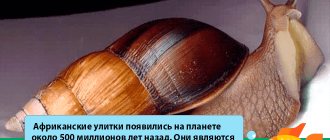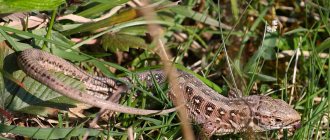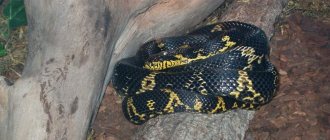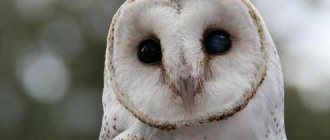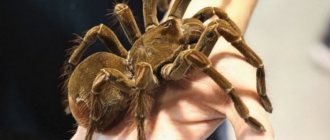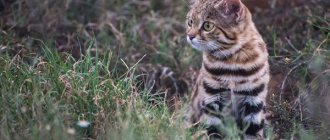Arhahatina Marginata with a beautiful bright color, active, willingly contacts the owner. It is recommended to get such individuals through trusted snail breeders or pet stores, so as not to encounter diseases. They are easy to care for and will enjoy a tasty treat.
- 1 Description and natural habitat
- 2 Mr. Tail recommends: variety of species
- 3 Basics of terrarium keeping
- 4 Feeding
- 5 Breeding
- 6 Diseases and prevention
Review of popular species and subspecies of Achatina
Giant Achatina are representatives of the subclass of land pulmonate snails .
They can increasingly be found in home collections. More and more people prefer to have these mollusks in their homes along with traditional cats and dogs. However, before you bring these cute creatures into your home, you need to learn about their varieties and some of the features of their maintenance. There are many types of Achatina in nature. It is impossible to provide a description of them all within the framework of one article, so we will consider brief characteristics of some of the names most often mentioned in the literature and among breeders.
Story
Achatina were brought to Europe from southern exotic countries. They live in large numbers in Africa, South America, Mauritius and other southern islands. Due to their enormous fertility, they are able to quickly populate entire colonies over vast territories, eating vegetation and damaging agricultural land. Therefore, in some tropical countries it is prohibited to breed and sell them. But in the temperate climate zone they do not survive and are able to reproduce only in artificial conditions.
They are considered the largest among all types of snails. The size of an adult individual can reach 20 cm. This snail attracts with its gentle disposition, lack of noise, odor and allergies, as well as a variety of shell colors.
general description
Archachatina marginalata is a giant tropical mollusk. The second name of the snail is fringed archahatina. Individuals of this species belong to the type of mollusks. Class – stalked gastropods. Despite the fact that snails lead a terrestrial lifestyle, they will not refuse water treatments. For this reason, they need to be bathed.
Arhachatina marginata - a snail with a rather beautiful body color
Under natural conditions it can be found in West Africa. The habitat is so large that it covers all territories, from Zaire to Cameroon. Ship traders spread the unpretentious mollusk throughout the United States, North and South America.
The second name of the snail is fringed archahatina
In regions with warm climatic conditions, archaeologists reproduce quite quickly. As a result, they become a real disaster for local residents. Because they destroy agricultural crops. The US is seeing a ban on gastropods.
Interesting Facts
The shell, which serves as a kind of house for the mollusk, grows throughout its life - the older the individual, the more turns the shell has. In addition, the shell can change its color depending on the food the animal eats. All Achatina are hermaphrodites, that is, they have male and female principles, and therefore do not need a partner for fertilization. If two individuals live in the same space, they are able to fertilize each other.
Not all species of Achatina lay eggs. Some of them are viviparous . These mollusks do not distinguish sounds at all, and only slightly distinguish halftones.
At home, snails live on average 4-5 years. However, with proper care and proper nutrition, Achatina can live up to 10-15 years.
Feeding
The Arhahatin diet includes:
- fresh fruits, vegetables;
- animal food;
- cereals.
The greens are given peeled. Hard varieties are ground on a grater. Among meat products, preference is given to beef, chicken, and fish. All this is boiled or given raw, but washed thoroughly, 2 times a week. On other days, protein foods include boiled eggs, dairy products, and daphnia. Cereals include oatmeal, boiled buckwheat, and mixtures of crops.
Food is not mixed, each type is laid out separately. This way, the snails have a choice and will eat what they need. The food is sprayed with water in advance to soften it. They feed once a day, in the late afternoon, when the gastropods begin their period of activity.
Sepia or crushed eggshells are given as a calcium supplement.
Excluded from the diet: salty, fried, spicy, pickled, smoked and sweet.
Varieties
If you decide to have such an exotic pet at home, you should learn to identify the breeds of snails and their subspecies. The living conditions of these snails are similar, but there are some differences in behavior and appearance. As already written above, there are a lot of different types of Achatina in nature - about 60 names , some of them have subspecies. Let's list the most famous of them.
Achatina achatina
They are easily recognizable by the tiger color of their shell: dark brown spots on a yellow background. Among them there are individuals with a standard color, and there are also albino Achatina, whose body is white, devoid of any pigment, and the shell is light yellow. It is believed that in this way the snail adapts to high temperatures in its homeland and protects itself from overheating. It is believed that albinos were first brought to Russia in 2009 by a breeder from Austria. Since then the population has been expanding.
At home, albino Achatina need to create conditions close to the tropics - increased temperature and humidity.
Achatina fulica
The most numerous and most unpretentious species of Achatina. It can go without food or drink for up to several weeks, and reproduce without any special conditions. It is customary to distinguish 5 main subspecies of Achatina fulica.
- Fulica standard . The shell itself is brown with various shades and mottled patterns, and the apex and columella (the inner part of the shell near the mouth) are white. Body color can range from light beige to dark brown.
- Fulica hemeli (hamillei). It can be distinguished from the standard one by its pink apex (the upper curl on the shell).
- Fulika albino body. The color of the shell can be anything, but the body is exclusively milky white. Some sources also mention its name “white jade”.
- Fulika rodatzi Dunker. The body and shell have a plain yellow color without a pattern.
- Fulica leucistic (Achatina fulica leucistic). They also have a white body, but the pupils are black.
Achatina glutinosa
Achatina glutinosa, translated from Latin as sticky - its shell has a glossy, sugar-like surface and seems sticky. It is somewhat smaller in size than the fulika - its length is about 10 cm.
Achatina reticulata
Reticulata (translated from Latin as reticulate) has a shell with a rough surface and a fine mesh pattern. The snail's head usually has a slightly brighter color compared to the rest of the body.
Achatina albopicta
At first glance, albopicta is very similar to reticulata. They can be distinguished by the presence of a pink apex. In addition, albopicta does not have such pronounced ribbing as the previous species. The final whorl on the shell is usually darker than the rest, and the first whorls have a mottled, uneven color.
Achatina iredalei
Iradelli is also called lemon because of its yellow shell. The size of the snails is small - only 5-8 cm. They differ from their relatives in that they do not lay eggs, but give birth to live cubs.
Achatina craveni
Cravens are also characterized by their small size (5-7 cm including shell) and are also viviparous. Kraveni do not tolerate heat well, so there is a high mortality rate among them at home. The optimal temperature is about +15... 20 degrees Celsius. They love high humidity.
Achatina
The following types of Achatina are most often found in home terrariums; see description with photo below.
Achatina Achatina (Achatina Achatina)
The largest species of African snails, the average shell size of which is 18-20 cm. The main color of the shell is yellow-orange with black or brown stripes. Thanks to this coloring, Achatina Achatina received another name - tiger. Columella is raspberry colored. A distinctive feature of the species is the tip of the leg with a V-shaped frame, like in representatives of the genus Archachatina. The color of the leg is gray - from pale to rich. Not suitable for beginners, as it is demanding on living conditions.
Achatina Albopicta (Achatina Albopicta)
A distinctive feature is its pink apex, which distinguishes it from Achatina reticulata, with which it can mate and produce viable offspring. The average size of the shell is 10-12 cm. The main color of the shell is yellowish-white with reddish-brown spots and stripes, the last turn merges into one dark spot. Columella is colorless or white. The body is monochromatic and light.
Achatina Craveni
Viviparous species. In captivity, the average shell length is 5-7 cm. The apex is not colored, the color of the columella is white or beige. Very high mortality rate in home conditions. Non-standard temperature regime – only 15-18 degrees.
Achatina Fulica
The most common type of Achatina. Suitable for beginners, because it is not as demanding on living conditions as Achatina Achatina. The average body size is 10-18 cm. There are many subspecies and color variations of both shell and body. The color of the shell can vary, mostly dark brown stripes on a yellow or white background, or a uniform brown or reddish-brown color. Columella can be white to bluish white. The apex is colored or pink (in the Hemeli subspecies).
Achatina Glutinosa (Achatina glutinosis)
This type of Achatina is not very common in private collections. It is similar to Achatina Fulica; when kept together, hybrids may appear. The average length of the shell is 10-12 cm, its main color is uniform red-brown, the apex is not colored. Columella is white-blue or light blue.
Achatina immaculata
All representatives of this species have columella with shades ranging from burgundy to purple, which differs from Achatina fulica. The apex is not painted. The leg is light in color with a characteristic stripe, the horns are short. Immaculates reproduce by self-fertilization. Such mollusks are suitable for beginners and inexperienced snail breeders.
Achatina immaculata var. “two-tone” (Achatina immaculata two-color)
A distinctive feature is that the shell is clearly divided into two parts. Its average size is 10-15 cm. The main color is that the shell is clearly divided into two transverse parts, one is dark brown, and the second is light yellow.
Achatina immaculata var. Immaculata (Achatina immaculata immaculata)
The average size of the shell is 10-15 cm. Its color can be varied, mostly dark brown, narrow stripes on a yellow or white background, there may be individuals with light brown stripes on a beige background.
Achatina Iredalei (Achatina Iredalei)
The main feature of this species is that these snails do not lay eggs, that is, they are viviparous. These snails are quite small, with an average shell size of 6-8 cm. Its color can vary from bright yellow to whitish yellow. The columella may be yellow or slightly whitish-yellow in color. The color of the head is darker than the legs.
Achatina Panthera (Achatina Panther)
A very interesting species of Achatina, which some malacologists attribute to the subspecies Achatina immaculata. The average length of the shell is 9-11 cm. The color can vary - dark solid, light pink, light brown, and sometimes with a greenish or purple tint. The leg is light with a bright stripe. They grow very quickly, cases of cannibalism are possible at an early age, so it is recommended to increase the amount of protein supplements.
Achatina Reticulata (Achatina reticulata)
The second largest species of land snails. The average size of the shell is 15-20 cm. The color is yellowish-white with reddish-brown spots and stripes, the apex is white or yellowish. The structure of the shell is corrugated. Columella is white or colorless. The leg is light brown or yellowish-cream in color, and the head is darker in color - from dark brown to black. She quickly gets used to human hands and becomes friendly.
Domestic…snails?!
Today, snails are popular pets, beautiful and interesting in behavior. There are many types of pet snails, from tiny to large and heavy. The contents and some types of domestic shellfish are in this article.
Keeping snails
For a comfortable life, the tropical snail requires warmth and humidity. A glass aquarium or a plastic container of a horizontal type for land snails, and a vertical one for arboreal ones, always with a lid, can serve as a home for snails. For large species of snails, it is advisable to have latches on the lid of the container, or a heavy object on the lid of a glass aquarium, as the snails can move the lid and go on an unsafe journey around the apartment. Ventilation holes are located above the ground and on top, but not in very large numbers, so that the humidity inside is maintained at 60-90% and the temperature is 24-27C. The volume of the terrarium should be such that the snail can comfortably turn around in it and, crawling along the lid, not touch the ground with its hanging shell.
- Under conditions that are uncomfortable for the snail, they can seal the mouth with a film (epiphragm) and hibernate - this should not be allowed for tropical snails. The longer the snail hibernates, the less likely it is to wake up, adjust the conditions, check all the parameters. To wake up the snail, turn the shell with the mouth up and spray it on the film lid with a spray bottle, or place the snail in lukewarm water, no more than 1 cm deep, with the mouth facing down.
Soil - moist fine coconut substrate or neutral peat; it is also good to use as a supplement leaf litter of oak, birch, hazel, any types of moss, such as sphagnum, branches and bark of deciduous trees, uncrushed bark of a cork tree in one piece, pieces of rotten wood may be suitable deciduous trees. The soil layer should be such that the snail can completely burrow into it. If necessary, you can spray the walls of the terrarium and the soil with water from a spray bottle. In the terrarium of large species of snails, you need to tidy up every day or every other day, removing feces and food debris, otherwise an unpleasant odor and even midges will appear. In small species, cleaning as they get dirty is worth replacing food daily to avoid spoilage. Complete replacement of the soil is carried out as it gets dirty.
Once every few days you need to wipe the walls of the terrarium from mucus and stuck soil; for this you will need a separate clean sponge; under no circumstances use the one you use to wash dishes or clean the sink - the snails can be poisoned by the residual detergents.
- Under no circumstances should you use paper napkins, newspapers, pebbles, large stones, shells, sand, flower soil, soil from the garden, hay, straw, sawdust as soil - all this can harm the health of your pet.
There is absolutely no need to bathe snails. If you are doing some general cleaning or just want to take a photo of the snail, you can give it a bath. To do this, you will need a clean, shallow container, boiled or settled water slightly warmer than room temperature, and a soft-bristled toothbrush or sponge. Pour water into the container so that it does not reach the spiracle, place the snail there and carefully water it from above (you can take a clean sponge, soak it in the same container and squeeze it out), the shell can be cleaned of dirt using a brush or sponge, avoiding growth, especially if it is a young snail and the growth is fragile. There is no need to bathe very small snails, and it is even dangerous.
Snail nutrition
All snails and slugs eat mainly plant foods with a small amount of protein supplements, with the exception of carnivorous species.
The diet consists of zucchini, pumpkin, carrots, lettuce, apples, pears, tomatoes, bell peppers, sweet potatoes, cucumbers, bananas, apricots, peaches, mangoes, strawberries, cauliflower, broccoli, Chinese cabbage, squash, spinach, watermelon, and mushrooms - champignons are best eaten; white mushrooms, aspen mushrooms and boletus mushrooms may be acceptable. In summer, you can give weeds collected away from roads and well washed - burdock, wood lice, leaves of dandelions, plantain, clover; leaves of apple, maple, linden, oak, raspberry, birch. Many snails love and eat yellow lichen - xanthorium, and for some species lichen is the main food and should be kept in the terrarium on a permanent basis. It is advisable to place food for snails in a bowl; small plastic bowls for cats, rodents or plastic trays for flower pots are excellent. It is not necessary to provide water to snails; they get moisture from food and by licking from sprayed surfaces, and the bowl is often turned upside down, the water spills, turning the soil into a swamp. If you want to make a pool for snails, it must be heavy and stable. Protein supplements are dried crustaceans - daphnia and gammarus, given in limited quantities. Mineral supplements are required - ground or lump feed chalk, crushed shell rock and egg shells, cuttlefish shell (sepia). Fertilizers can be sprinkled either on food or placed in a separate bowl. Young growing snails of any species need to be fed daily. In the evening, thinly slice fresh vegetables, sprinkle with calcium mixture, add protein supplements (growing snails can be given protein a little every day, since they have a higher need for protein than adults). Adult snails may eat less frequently and may be given less feeding.
You should not feed domestic mollusks with food from your table: no pasta, cookies, potatoes, soup, sausage, bread, or any salted, fried, fatty, sour or spoiled foods should be in the snail’s diet. In addition, there is no need to offer mineral blocks as a source of calcium to birds and rodents.
Snails are nocturnal animals and should be fed in the evening when they wake up.
Diseases and injuries of snails
Snails, like any other living creature, can get sick. The main causes of diseases are improper living conditions and careless handling.
- Overheat. The snail becomes lethargic, swollen, slow, becomes covered in excess mucus, refuses to eat, goes deep into the shell or lies like a rag. Direct sunlight is especially dangerous, so you should never leave containers with snails in the open sun. Prolonged or sudden severe overheating often leads to the death of the snail.
- Thermal burns. When washing the snail, you should use cool water, and any heating devices and lamps should be out of the snail's reach. The burn is accompanied by damage to the soft tissues of the cochlea, the formation of wrinkled areas and blisters. The mollusk becomes lethargic and inactive, and does not use the burned part of the body to move. If the burn is on the tail or leg and is not very large, after some time it will heal with the formation of a dark scar. If the head is burned, or tissue necrosis begins, accompanied by an unpleasant odor, the outcome can be sad.
- Chemical burns. You should not let the snail crawl freely, leave it in the sink or bathtub, or use various detergents and chemicals on it. A snail can get burned when its body is exposed to household solvents, detergents and washing powder, soap, lotions, cosmetics, alcohol, hydrogen peroxide, vinegar, etc. The symptoms are similar to a thermal burn.
- Bites by other snails. This also happens, with a lack of nutrition and protein supplements, crowded housing, heavily polluted soil, one snail can gnaw the body of another, scraping off the upper part of the “skin” of the snail, leaving white eaten marks. Most species are capable of cannibalism. If they gnaw on a smaller and weaker snail, it may be eaten completely. After the gnaws, they heal with the formation of light or dark, almost black scars, restoring the entire texture of the body, and even parts, for example, can grow an eye or tail again. When gnawing in a terrarium, you need to eliminate the source of stress and adjust the conditions and nutrition.
- Prolapse of the mouth and stomach, prolapse of the genital organ. The exact cause and effective treatment for these diseases in snails are unknown. When the mouth prolapses, the digestive organs, pharynx, and stomach turn outward in the form of a mucous bladder filled with a clear or blue liquid. Puncture of the bladder wall and repositioning the organs in place can help reduce the pressure in the bladder, but, unfortunately, if it has prolapsed once, it will prolapse again and again. When the snail's genital organ prolapses, it is located outside, on the side of the head, and the snail cannot set it back on its own. It happens that within 1-2 days the genital organ falls into place on its own, but it also happens that the snail injures it on objects, begins to gnaw it itself, and the organ may begin to die. To avoid the death of the snail, amputation of the genital organ may be necessary; its absence will not greatly affect the future life of the snail.
Damage to the shell.
If handled carelessly and if maintenance rules are not followed, the sink may break, become thinner, or become scratched. Frequent damage:
- Growth failure. The growth is located near the mouth of the growing young snails and is a thin film, usually yellow in color. Most often it is injured by fingers when the snail is picked up incorrectly, and also breaks when falling from the lid, and can be crushed on the edge of the bowl and even on the neck of the snail itself. It overgrows quickly, leaving a mark on the sink.
- Breakage of the apex (tip of the shell) and other parts of the shell. The apex often breaks without human intervention, especially in older large Achatina, whose apex is small and thin. Young snails can also break, especially if there is insufficient nutrition and high humidity in the terrarium. Large coils break off when dropped onto hard surfaces, when the shell becomes thinner due to high humidity, dirty, swampy soil, or nibbled by other snails. If the damage is minor, there is no need to do anything; the snail will heal the chip from the inside. If the shell is severely broken and soft organs are visible, you can try to restore it by sealing the chip with eggshell film and fixing it with adhesive tape; the outcome may be unfavorable.
- Scratches and deposits on the sink. They are found in older snails; due to age, the conchiolin layer wears off and white scratches remain. May appear when kept on hard soil, gravel, pebbles, sand, in conditions of high humidity and pollution. Only the appearance suffers; usually, abrasions and scratches do not interfere with the snail itself, unless the shell is so worn out that it has become thin and fragile.
Types of domestic snails
Almost any snail can be kept at home, taking into account the peculiarities of their maintenance. Tropical land mollusks need warmth and humidity, arboreal mollusks need warmth, humidity, twigs, mosses and lichens, midland snails need periods of drought and humidity, as well as hibernation, midland slugs need humidity and cool temperatures. Let's look at the most popular types of snails kept at home.
Achatina
Achatina is a genus of tropical land snails that includes many species from very small to huge. They have a conical elongated shell with a pointed end (apex, the top of the shell), a soft, almost textureless body, from beige to dark brown in color, albinos are often found, and they secrete quite a lot of mucus. They lay small oval eggs in a dense shell from 50 to 400 pieces at a time, small snails hatch after 2-4 weeks, the first days feeding on the remains of their eggs, later crawling around the terrarium in search of food. There are also ovoviviparous species, for example Achatina iredalei, the eggs develop inside the snail, and already formed snails are born, in this case the number of clutches is much smaller.
Achatina fulica is the most common species. It has a smooth shell up to 20 cm long, usually less - 12-15 cm, mostly brown in color, it can also be almost black, greenish, yellow with indistinct stripes or without stripes. It has a rather soft and smooth body from light beige to dark brown, albinos are often found.
Achatina reticulata. One of the fastest growing and largest species, with a thin ribbed shell that grows with good care up to 18 cm, and can even be larger, and a soft body - from light beige to brown with a black head, or albinos.
Achatina was destroyed. A small species with a light soft body and a yellow shell 5-7 cm long. It produces 15-25 formed independent snails.
Achatina panther. This snail's body has a reticulate pattern of dark veins, ranging in color from light beige to deep auburn, and a dark stripe on the neck from the head to the shell. The shell is smooth, 10-12 cm long, brown or reddish in color; with age, the conchiolin layer may peel off, and the color of the shell will become lighter.
Achatina immaculata. The body is very similar to the body of the Achatina panther, but the shell is more rounded, dark, with a small zigzag pattern, 9-12 cm long.
Achatina craveni. Another small representative of the Achatina genus. The size of an adult shell reaches 5-7 cm, the color is beige, yellowish, the surface is smooth. From the earliest turns, the shell is decorated with continuous or intermittent longitudinal brown stripes. Just like Achatina Iradelli, it produces “ready-made” snails.
Achatina Achatina, or "tiger". The body is beige to almost black in color, the structure of the leg is dense, granular in texture, the leg is notable for its “crocodile” tail. The tiger is the only representative of the Achatina genus with such a tail. Albinos are also common. The shell is smooth, on average 12-14 cm; in domestic molluscs there are individuals up to 15-16 cm in size; the record size of the shell of a natural specimen is 28 cm (this size is officially recorded in the Guinness Book of Records). The shell has very bright contrasting yellow and black stripes. Achatina Achatina, unlike other species, continues to grow throughout its life, but very slowly.
Archhatina
A genus of land snails, from small - 5-7 cm to large - 15 cm species. Distinctive features are the rounded tip of the shell, a dense textured body and a “crocodile” tail. They lay 5-15 large eggs at a time, and the snails also emerge large and developed.
Arhahatina marginata ovum. Dense textured body, from light beige to dark brown; albinos are also found, “acromelanics” - with a white body and gray horns, and “silvers” - with a silver-gray body. The shell is heavy, of various shades of ocher, yellow and red, with dark stripes or specks, 12-14 cm long.
Archachatina marginalata suturalis. They are similar to ovums, the colors are the same, the shell is more elongated, brighter and has a pink tip.
Archachatina papyracea. Shell: 6-8 cm, the first coils are colored in brown-beige tones, striped, the large coil is single-colored - brown or greenish. The body is soft, ending with a crocodile tail, somewhat less pronounced than that of snails of the genus. There is a brown stripe along the neck, the color varies from beige to brown.
Arkhahatina puylaerti. The body is soft, spreads over the surface when moving, has a crocodile tail, but somewhat less pronounced than that of other archachatina. The color of standard individuals varies from beige to dark brown, with a brown stripe running down the neck. Albinos are most often found in collections.
Archhatina egregia. The shell is 8-10 cm, bright, usually with a predominance of dark tones, the texture is smooth. The body is quite rigid, dense, and has a crocodile tail. The color of standard individuals varies from beige to dark brown, sometimes almost black. The horns and head are darker colored than the body, usually the dark gray or dark brown color of the horns smoothly turns into the brownish-beige color of the legs and ends with a beige tail; albinos are also often found.
Arhahatina marginalata marginalata. The shell is massive, round, thick-walled, on average 10-12 cm, and has black and white longitudinal stripes. With age, it peels off, the shell becomes dull and whitish with a greenish tint, but this makes it no less impressive. The body is dense, black or dark brown, with a grainy texture, usually a little lighter towards the tail.
Tree and other small species of snails
Unusual-looking small snails that prefer to crawl along the ground on twigs and walls of the terrarium. To keep them, you need a high terrarium, with soil, litter, and, of course, branches with lichen. Eggs are laid in the ground, often have a soft shell, 5-15 eggs at a time. Tree snails in nature live in colonies; keeping them alone is not recommended.
Caracoluses. Brightly colored snails with a round flat shell about 5 cm in diameter, decorated with stripes; plain, almost black, and white shells can also be found. The body combines black, silver and red shades.
Pleurodont excellence. A relatively large snail, up to 7 cm in diameter, with an almost black flat shell, a black and orange body and white bands on the eyestalks.
Pleurodont isabella. A small species of snail with a black-gray body and a striped shell, there are also options with a white and light ocher “amber” shell, about 2 cm in diameter.
Pseudoachatina leyana. They have a ribbed light shell, elongated, 6-7 cm long, and a bright red body. They grow very slowly; moss and lichen are required in the terrarium.
Limicolaria. Small active snails, with an elongated shell 6-7 cm long, white (unicolor color), or light color with dark stripes (flammea), Limicolaria species are also found with other shell colors, for example pinkish-orange. The thin long neck has longitudinal stripes.
Subulina octone. A small species of snail averaging 1.5 - 4 cm in length. They reproduce very quickly, eggs and snails are about 1 mm. Yellow body color, transparent light yellow shell, very elongated.
Chemiplects Siamese. Small snails with a finely ribbed round shell, yellow or reddish-brown above and white below, and a gray body. Fast and active.
Megalobulimus
A peculiar snail with an ovoid shell 7-8 cm long, amber in young ones, matte beige in adults, a bright pink “lip” - the edge of the shell, and a soft, jelly-like gray or beige body. The most distinctive feature of megalobulimus is their amazing fan of lower tentacles. This is a tactile-olfactory organ that the snail opens to recognize the smell of food, feel an object, and even to catch droplets of water (during rain in nature or when swimming in captivity). Sexual maturity is reached by 3 years. After mating, 10-12 eggs are laid in pairs, 4-5 weeks apart. The eggs are very large, oval, on average 2 cm long and 1 cm wide. For food, they prefer lettuce leaves and soft vegetables and fruits (plums, bananas, mangoes (highly ripe), tomatoes), and boiled chopped carrots are excellent.
Tropical slugs
The species most often kept at home are species of the family Veronicellidae, which have a flattened oval body and a “hood” over the eyes. The eggs are transparent, oval, collected on one thread, like beads; the development of the embryo can be observed through the shell. For the first day, the slug that laid the clutch remains near it, wrapping its body around it, and then leaves and never returns. For slugs you need a horizontal terrarium, with coconut soil, moss, and leaf litter. They enjoy eating lichens, mushrooms, and fruits. The terrarium must have a tight-fitting lid; slugs can squeeze into the narrowest cracks, and outside the terrarium they quickly die without moisture.
Snails and slugs of the middle zone
At home, you can also keep mollusks that live in Russia.
To keep them, first of all, you need to find out the type of snail, and then where it lives in nature. Conditions should be close to natural. Some species require summer drought, when moisture and nutrition stop, the snails are sealed with lids and sleep for about 1-2 weeks, then the “rainy period” begins - moisture and nutrition are restored. Most need hibernation; the soil also dries out, feeding stops, and the snails are placed in a cool place for 1-2 months. Slugs almost always require cool temperatures and high humidity; at high temperatures they quickly die. Grape snail helix pomatia
Limax maximus slug
Chains
Arianta
Xeropicts
Fruticols
Archachatina
These types of archaeologists are often kept at home:
Archachatina degneri
The average shell size is 10-12 cm. The main color is brown or red-brown with yellow stripes, the apex is beige. Columella is crimson or purple in color.
Archachatina marginata
Archachatina marginata eduardi
A small shell - 8-10 cm, striped with a predominant brown color. The apex is beige or yellow. Columella is bluish-white.
Archachatina marginata egregia
Snails with small shells - 8-10 cm. The shells are bright, with predominant dark tones, and two-tone colors are common. Apex pink. Columella crimson color.
Archachatina marginata marginata
It is distinguished by a massive rounded shell, the average length of which is 16-18 cm. Color - light and dark brown stripes, evenly distributed stripes on a yellow background, with spots and inclusions. Columella is white. The color of the apex is a pale pink shade or not colored. The leg is a rich dark color.
Archachatina marginata var. ovum (Archachatina marginalata ovum)
The size of the shell of representatives of this species can reach up to 18 cm. A distinctive feature from other arches is the yellow apex. The main color of the shell is a yellow or beige background with brown stripes. Columella is yellow or peach in color.
Archachatina marginata var. suturalis (Archachatina marginalata suturalis)
Representatives of this species are distinguished by a bright pink apex and pink or crimson columella. The average size of the shell is 12-14 cm. The color of the shell is slightly darker than that of ovums.
Archachatina papyracea
The size of the shell can reach up to 10 cm. The first turns are beige-brown, striped, the last turn is monochromatic with a brown or greenish tint. Columella has a crimson or purple hue. The apex is more pointed than in other representatives of the genus, and is beige in color.
Archachatina puylaerti
The size of the shell is up to 12 cm. The first whorls are beige-brown, striped, the last whorl is greenish, olive or brown-green with stripes or spots, the apex is beige. Columella crimson or purple.
Archachatina ventricosa
The shell size is up to 12 cm. The first whorls are red-brown in color, the large whorl is olive or bright green with brown stripes and spots. The apex is yellowish or reddish. Columella is raspberry or purple in color.
In this article, we tried to describe the types of Achatina and the types of Archatina that are most often found in home collections. We will talk in more detail about each type in separate articles. Health to you and your pets!
Nutrition
The archahatina marginalata snail has a good appetite. This species is not picky about food. However, each individual may have a food preference for completely different foods. For example, some people enjoy eating fresh zucchini. Others prefer apples. For this reason, it is recommended to monitor the taste preferences of gastropods. What allows you to give them treats that will definitely suit their taste.
The archahatina marginalata snail has a good appetite
Despite some preferences, individuals of this species are omnivores. The basic diet includes fresh vegetables, fruits, and herbs.
In addition, they are perfect for feeding:
- Cabbage leaves.
- Cucumbers.
- Salad leaves.
- Tomatoes.
- Spinach.
- Zucchini.
- Apples.
Before feeding the snails, the food should be prepared first. Vegetables and fruits are thoroughly washed under running water. Then grind it well. You will also need to use special additives. Thus, gastropods require calcium. This will make the sinks not only strong, but also beautiful. For these purposes, crushed egg shells, cottage cheese, and chalk are added to the main food.
For rapid growth and weight gain, a large amount of protein is required
For rapid growth and weight gain, a large amount of protein is required.
Protein is found in the following foods that can be given to archaeologists:
- Mushrooms.
- Quail eggs.
- Meat.
- Corn.
- Legumes.
It is recommended to feed in the evening. It is during this period of time that archahatines show maximum activity. The food is served in a special feeder. You can use any shallow container. Do not leave food on the substrate. In the morning, if there is food left, it is removed. This approach will prevent food from rotting. In conditions of high humidity and temperature, food decomposes as quickly as possible.
Achatina fulica (Achatina fulica)
Fulica lives in tropical climates. The length of the mollusk is 20 cm. In a terrarium it grows up to 17 cm. The shape of the shell is conical with 6-9 turns. Body color is beige, light brown, less often black. The structure of the sole is coarse-mesh. Read more about housing and feeding here .
The color of the shell varies from dark brown to red. As the shell ages, it develops dark streaks and blurring. Apex brown, less often sandy, pointed. Columella is white or bluish in color.
Achatina Fulica umbilicata Neville
The snail does not require constant care and is inexpensive to maintain, which is why novice terrarium keepers choose it. The snail is omnivorous and gluttonous. Loves water, but does not tolerate waterlogging in the terrarium.
Active at temperatures from 20 to 28 degrees and humidity from 65% to 75%. In captivity, it lives up to 8 years. Achatina fulica becomes sexually mature at 5-6 months, with a clutch of 250 to 700 eggs. Egg size is 5-6 mm.
The fulika moves calmly and slowly. Watching her calms her down. In the first half of the day, she chooses a quiet place and takes a nap there. She is timid and makes a squeak when she hides in a shell. With poor care, it hibernates for up to 9 months.
In a community of relatives, compliant and friendly. The snails eat in turns, without interfering with each other. To keep 1 fulika, a terrarium volume of at least 15 liters is required.
Achatina Fulica sinistrosa Grateloup
Varieties of Achatina fulica:
- Achatina Fulica hamillei Petit
- Achatina Fulica rodatzi Dunker
- Achatina Fulica sinistrosa Grateloup
- Achatina Fulica umbilicata Neville
Achatina Fulica hamillei Petit
Shared content
Cohabitation of different species is only partially possible, since variations and subspecies of the same species can produce hybrids and also cause nuisance to animals.
But there are cases when two subspecies or even different genera get along well, for example:
- Achatina fulica and Achatina reticulata;
- Limicolaria flammea and Caracolus sagemon.
For clarity, we have depicted the compatibility of different types of snails in the table.
Achatina reticulata
Also a popular species among snail breeders. She is originally from Zanzibar. The length of the corrugated shell is 18 cm. The color of the shell ranges from light beige to brown with dots and axial stripes. The apex is beige or sandy, the collumella is white. The body and head of the reticulum are beige or brown, and the edges of the sole are light. Read more about care and reproduction in our article .
The snail is active, sociable and curious. Always cranes his head to keep abreast of events. She is smart, learns quickly, and you can easily teach her to eat by the hour. Gluttonous, eats everything.
Achatina reticulata dark head
Active even in the first half of the day, becomes attached to the owner and distinguishes him from strangers. Favorable temperature for life is from 25 to 27 degrees and humidity from 60% to 75%. In captivity, it lives up to 6 years. At 10-12 months the snail becomes sexually mature; the clutch contains 300 eggs, 7-8 mm each.
Albino snails are valued among snail breeders. This variety of reticulata albino is smaller in size and grows slower than its counterparts. Their length is 15 cm. The color of the body and head is white. The color of the shell, apex and columella is milky white. Mobile, active mollusks easily come into contact with humans.
How to distinguish
How to determine what genus a snail belongs to - Achatina and Archachatina? Let's figure it out.
To determine the genus of a snail, it is necessary to take into account various characteristics. And then you will immediately see the differences between Arhahatina and Achatina. You can determine whether you belong to a particular genus or species by:
- Apex;
- The tip of the leg;
- Body structure;
- Columella;
- Behavior;
- Size and number of eggs.
Apex
The tip of the shell, the apex, is one of the most important distinguishing features between the genera Archatina and Achatina. Achatina have a pointed apex, while Archatina has a more rounded apex. In addition, the color of the apex can be used to determine the type or subspecies of a gastropod.
Tip of the foot
All species belonging to the genus Archachatina have a V-shaped tip with a characteristic groove; it is also called crocodile. You can easily feel this groove by wet your finger and run it along the snail's tail.
Representatives of the genus Achatina do not have this feature, with the exception of the species Achatina achatina (tiger), but tiger Achatina can be easily identified by a number of other features. Sometimes it may seem that Achatina has a light groove at the tip of its tail. But it's just a color change and it's flush with the rest of the leg.
Body structure
How else do Achatina differ from Arhachatina? Another sign of belonging to one of these genera is the structure of the soft body. Carefully examine the clam's leg. Achatina has soft and smooth skin, divided into large segments. At the same time, Archachatina has hard skin, divided into small protruding cells, rough to the touch.
Columella
In most cases, the color of the columella can be used to determine whether a snail belongs to a particular species (subspecies). To do this, take the gastropod so that the apex is pointing down and carefully move the mantle away. The color, shape and structure of the shell are often characteristic of one genus. In particular, the color variations between species are very similar, so species identification should not be made solely by the shell.
Behavior
Differences between the two genera can also be seen in behavior. The Achatina snail is very active and mobile, quickly gets used to a change of environment, exploring the space around it.
The Archhatina snail, on the contrary, is unhurried, slow, one might say lazy. Representatives of this genus are often shy.
Reproduction
The difference also appears during reproduction. Achatina becomes sexually mature by six months; on average, one clutch can contain 100-300 eggs, 0.5-0.9 cm in size.
Arhachatina become sexually mature much later - at the age of 1-1.5 years, in a clutch there can be up to 20 large eggs - up to 2 centimeters.
Achatina and archachatina are divided into subspecies, which we will briefly discuss in the next article.
Achatina immaculata
Immaculata is similar to fulica. Her homeland is Tanzania. She is popular as a pet. Unpretentious, omnivorous and beautiful. See more useful information about immaculata here .
The length of the plump conical shell is 12 cm with 5-6 rounded turns, like a “striped watermelon”. The color of the shell varies from light brown to dark brown with even stripes. Apex beige or sand. Achatina immaculata is distinguished by its pink-violet columella. To see this, pull back the snail's mantle slightly.
Achatina immaculata panthera
The body of the immaculata is light beige, thicker and larger than that of the fulik, with a characteristic stripe on the neck.
The snail grows well and reaches sexual maturity at 9 months, laying 150 eggs of 6 mm each. Unusually, it reproduces by self-fertilization. 25 - 27 degrees is a comfortable temperature for living. Humidity 75%-80%.
Achatina immaculata var. panthera
Among snail breeders, immaculata panthera . The content is an unpretentious snail. Sociable and friendly. It can sometimes hibernate in winter. It grows slowly and reaches 10-15 cm in length.
The body color is light pink with a peach stripe across the entire head. The sole is soft with a mesh pattern. The shell is light in brown stripes without blur and dots, conical in shape. The apex is light, the columella is crimson. With a lack of calcium, immaculate, the panther can gnaw on the shells of its neighbors. The volume of the terrarium for 1 Achatina immaculate is 15 liters.
Achatina immaculata Smitty - Achatina immaculata var. smithii
Varieties of Achatina immaculata:
- Achatina immaculata var. smithii
- Achatina immaculata var. panthera
- Achatina immaculata var. immaculata "two-tone"
Achatina immaculata immaculata “two-tone”
Breeding
During the first year of life, Arhahatina experiences active growth and puberty. To get a healthy and beautiful individual with good genetics, it is necessary to create comfortable living conditions, a nutritious diet, and calcium to strengthen the shell. After the first year of life and the onset of puberty, growth slows down and stops completely by two years.
For crossing, two individuals with different roots are selected. If they are close relatives, you can get sickly hybrids. The genetics of the offspring will only get worse each time.
To mate, the Arhahatina snail climbs second onto its shell. When the partner is ready to mate, he throws his head up and they begin to shake their necks. Then they connect. The reproductive organ of gastropods is located on the right cheek in the form of a bump; when they mature, it becomes whitish.
Pregnancy lasts a month. Then one or both partners lay a clutch of 7-20 eggs under the ground. Small snails will appear within a month. For the first few days they will live underground and feed on calcium-rich shells. Then they will get out on their own. If they can’t do it themselves, then it’s worth loosening the soil a little to help them.
Achatina albopicta
Albopicta is similar to Achatina reticulata. Tanzania and Kenya are its homeland. The ribbed shell reaches 16 cm, the color is marbled with brown veins. A characteristic difference is that the columella is white or yellow. Apex pink or white. More useful information about albopicte here . The mollusk grows quickly, reaching 12 cm in six months.
It is not a demanding, omnivorous and friendly pet. The temperature in the terrarium is 26-29 degrees, and the humidity is 80%-90%. Leads a nocturnal lifestyle. During the day he buries himself in the litter and sleeps.
Reaches sexual age at 9 months, in a clutch of 250 eggs of 5 mm each. The volume of the terrarium for 1 Achatina albopicta is 20 liters.
Achatina albopicta - Achatina albopicta
Lemon Achatina (Achatina iredalei)
Iradelie is originally from Zanzibar. The conical shell measures 6 cm with 4 turns. This species received its name for the lemon-yellow color of the shell and the cream color of the sole. The color of the head is darker than that of the sole. The apex is sandy or yellow, the columella is yellow.
This snail is viviparous (does not lay eggs). It becomes sexually mature at 7 months, and 25 snails, each 1 cm in size, are born every six months.
Akhatina Iradelie
She is active, sociable and curious, unpretentious to the conditions of detention. Loves water and tasty food. 23-28 degrees is the optimal temperature for lemon snail. Humidity 70%-90%.
It is nocturnal, squeaks, rustles and eats. Distinguishes the owner from strangers. She loves to be held. The volume of the terrarium for lemon Achatina is 10 liters.
Varieties of Achatina iradelei:
- Achatina iredalei albino
Achatina iredalei albino
Basics of terrarium keeping
The aquarium is chosen horizontal, with a capacity of 10-20 liters per individual. The bottom is covered with tropical soil (coconut substrate, moss, etc.). The thickness of the layer is selected individually, the main thing is that the snail can burrow into the filler. The temperature is set at +26…+28 °C, above +30 °C they may die. They do not tolerate drafts and sudden changes well, so you should not expose them to instant cold and warm temperatures. Humidity 75-85%, depends on the preferences of Arhahatina.
You can maintain it by placing a bowl of water in the terrarium and periodically spraying the soil.
Brown Achatina (Achatina glutinosa)
The snail is similar to the panther and fulica immaculata. Mozambique and Malawi are her homeland. The size of the mollusk reaches 12 cm. The shell is massive, ovoid-conical in shape, dark brown in color with brown stripes. Apex brown, slightly rounded. Columella is white or blue.
The body is massive, gray-brown with a darkened stripe on the head. With good care it grows quickly. He loves water and swimming, combining communication with the owner and water procedures.
Brown Achatina is sociable, omnivorous and active - even in the daytime. The optimal temperature is 25 - 28 degrees. Humidity 65% - 70%.
Rarely found in home terrariums. It becomes sexually mature at 7 months, with a clutch of 300 eggs. The volume of the terrarium for brown Achatina is 15 liters.
Achatina glutinosa
Achatina "tiger" or common Achatina (Achatina achatina)
The largest species of African snail. At home in Nigeria, its size reaches 33 cm. However, in captivity it grows up to 25 cm. The weight of the mollusk is 400 grams. The color of the barrel shell varies from lemon yellow to tan, with black-brown stripes and dots. The apex is yellow, the columella is crimson or pink. There is a separate article on the site dedicated to the tiger snail - read .
Achatina "tiger" - Achatina achatina
The body color is black or brown, but there are also albinos with white legs. They are calm and lazy by nature and prefer to sit in one place. They sleep a lot in the bedding, distracted only by food. Slow and unsociable.
They are demanding on nutrition and living conditions and grow slowly. They reach sexual maturity at 2 years, in a clutch of 100 eggs of 7 mm each.
Achatina Аchatina Albino
Content temperature 26-30 degrees. Humidity 70%-90%. It is rare to find snail breeders in terrariums. The volume of a terrarium for an Achatina tiger is 30 liters. Albinos require special care, see here .
Achatina achatina roseolabiata depravata
Exotic dishes are prepared from the meat of Achatina vulgaris. Its meat is believed to cure tuberculosis.
Varieties of Achatina Achatina:
- Achatina Аchatina Albino
- Achatina achatina roseolabiata depravata
- Achatina achatina elegans monochromatica togënsis bayoli
Achatina achatina monochromatica togënsis bayoli
When can we expect offspring?
Archachatina marginalata ovum becomes ready to breed offspring by the age of one year. She is capable of laying up to 25 eggs at a time. The size of one can reach 0.5 cm.
There are a lot of offspring, which is good for those who specifically breed them. But for ordinary lovers, such a number of pets is not necessary. Therefore, eggs are frozen and then thrown away or eaten.
People who specifically raise snails put the clutches in a separate container. They also provide the required temperature and humidity levels. They need to be removed because they can be damaged in a common terrarium, or they can be eaten by adults.
After 14 days, the cubs are born. They should also be kept away from their parents for some time. For a month you need to feed them with herbs, calcium and protein supplements. Then you can slowly switch to an adult diet.
Arhahatina marginata ovum are very beautiful animals, whose presence in the house allows you to always maintain a rosy mood. After communicating with them, you always leave a pleasant impression.
